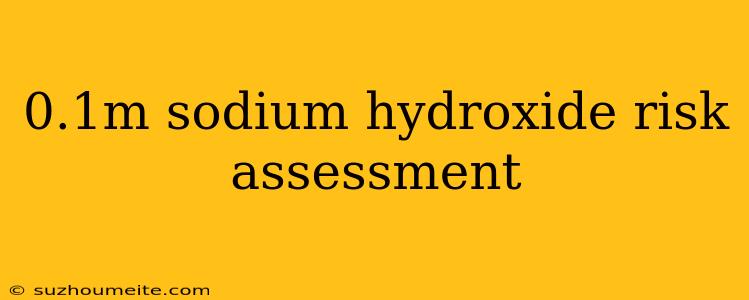0.1M Sodium Hydroxide Risk Assessment
Introduction
Sodium hydroxide, also known as caustic soda, is a strong base commonly used in various laboratory and industrial applications. A 0.1M sodium hydroxide (NaOH) solution is a diluted form of this substance, which is still hazardous and requires proper handling and safety precautions. This risk assessment aims to identify the potential hazards associated with 0.1M NaOH and provide guidelines for safe handling and use.
Hazards Identification
Physical Hazards
- Corrosive: 0.1M NaOH can cause skin and eye irritation, and can corrode metals and other materials.
- Irritant: The solution can cause respiratory irritation and can be harmful if inhaled.
Health Hazards
- Skin Contact: Prolonged skin contact can cause burns, redness, and blisters.
- Eye Contact: Splashes can cause severe eye irritation, conjunctivitis, and even blindness.
- Inhalation: Inhaling mist or vapors can cause respiratory tract irritation, coughing, and shortness of breath.
- Ingestion: Swallowing the solution can cause severe burns to the mouth, throat, and digestive tract.
Environmental Hazards
- Aquatic Toxicity: 0.1M NaOH can be toxic to aquatic organisms and cause long-term damage to aquatic ecosystems.
Risk Assessment
Likelihood and Severity of Risks
- Skin Contact: High likelihood, moderate severity
- Eye Contact: High likelihood, high severity
- Inhalation: Moderate likelihood, moderate severity
- Ingestion: Low likelihood, high severity
- Environmental Hazard: Low likelihood, moderate severity
Control Measures
Personal Protective Equipment (PPE)
- Wear protective gloves, lab coats, and safety glasses or goggles.
- Use a face shield when handling large quantities or performing procedures that may generate splashes.
Handling and Storage
- Handle the solution in a well-ventilated area, away from heat sources and open flames.
- Store the solution in a designated area, away from incompatible chemicals and materials.
- Label containers and storage areas with warning signs and hazard warnings.
Emergency Procedures
- Spills: Neutralize the spill with a weak acid, such as acetic acid or vinegar. Wear PPE and follow established spill response protocols.
- Skin Contact: Flush affected area with water for at least 15 minutes. Seek medical attention if irritation persists.
- Eye Contact: Flush affected eye with water for at least 15 minutes. Seek immediate medical attention.
Conclusion
The risk assessment highlights the potential hazards associated with 0.1M sodium hydroxide and provides guidelines for safe handling and use. It is essential to follow proper safety protocols, wear appropriate PPE, and handle the solution with caution to minimize the risks associated with this substance.
